General
Origin of heraldry
At the end of the 12th century, at the time of the Crusades, precise and until then immutable laws governed the principles which the science of the coat of arms, called “Heraldry”, must obey. It is now certain that the origin of coats of arms, in this form, dates back to the 11th century, when helmets with nose protection were used. The soldier could not then be recognized. The knights will then paint geometric, animal or vegetable figures on their shields. Recognition on the battlefield is therefore the element that contributed to the creation of heraldry. To be able to gather quickly near the battle leaders by showing off banners and other pennants in the colors of each.
The shape of the shield
The shield has taken different forms depending on its origin or destination. Its surface is divided into nine partitions. The right side of the shield (dextre) corresponds to the left of the person looking at it. It is the same for the left side (senestrum). From its shape, we know if the coat of arms of the shield has French, Swiss, German origins...
 |  |  |  |
| Old French shield | Ladies shield | Crest of the Maidens | Tournament Crest or Banner |
|---|---|---|---|
 |  |  |  |
| French shield | Iberian shield | Italian shield | English shield |
The divisions of the shield
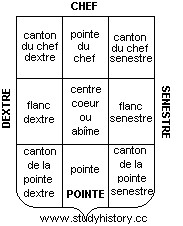
The colors
Colors fall into two groups:metals and enamels. There is also a schematic code (dots, lines, etc.) that corresponds to each color. A planet and a precious stone are also associated with each of the colors as well as a list of virtues. The colors cannot be used in any way and their superposition obeys strict and imperative rules. We cannot therefore superimpose two colors of the same group, for example if the table of the shield is gules (red), the lion it will bear can only be gold or silver (yellow or white metal). If the rule is not applied, the weapons are said to be "at right angles".
| Metals | ||||
|---|---|---|---|---|
| Gold (yellow) |  |  | The Sun - Topaz | Intelligence - greatness - virtue |
| Silver (white) |  |  | The Moon - the Pearl | Sharpness - purity - wisdom |
| Enamels | ||||
| Gules (red) |  |  | Mars - the Ruby | Love - patriotism |
| Purple (purple) |  |  | Jupiter - the Opal | Courtesy - peace |
| Azure (description) |  |  | Venus - the Sapphire | Beauty - fidelity - perseverance |
| Sinople (green) |  |  | Mercury - Emerald | Health - hope - freedom. |
| Sand (black) |  |  | Saturn - the Diamond | Sadness |
Fur
Seven kinds of fur among the constituent elements of a coat of arms, the best known of which is the ermine which adorns the arms of Brittany.
| Ermine |  | Field of silver speckled with small sand crosses with a wide base and ending in three points. |
|---|---|---|
| Counter-Hermine |  | The reverse of the ermine. Silver speckled sandy bottom. |
| Vair |  | Small silver and azure pinnacles alternating head to tail. |
| Counter-Vair |  | Small pinnacles of azure and silver joined two by two. |
| Converse Vair in peak |  | The pinnacles of the same shape and color are aligned vertically. |
| Vaire |  | Charged with Vair when the colors are different from Vair and Counter-Vair. |
| Counter-Vairé |  | Charged with Contra-vair when the colors are different from Contra-vair. |
The different types of coats of arms
- The talking ones
- They have a relationship with the family name, for example three hammers to designate the Martel family (they sometimes appear as rebuses).
- Allusives
- They refer to an event or an exploit during which the family or one of its members distinguished themselves. The coat of arms of Austria bears a band of silver (white) on a background of gules (red) (we find the same arrangement on the current flag of Austria). This to recall the wound of Duke Leopold II, his armor was covered in blood, only his belt remained white.
- Policies
- They recall a link uniting a group:trades, states or regions united by a pact.
- Symbolics
- They evoke an idea or a concept.
Scores and honorable pieces
Scores and honorable pieces
The shield can be divided into equal parts, by a line whose directions are those corresponding to the four orientations of the blows of the sword given with the cutting edge. These are the great warrior blows. These determined parts on the ecu are called partitions . But the shield can be divided by several lines, that is to say two lines and three partitions; five lines and six scores; which forms on the surface of the shield a different design which is called honorable piece .
| Partitions | Honourable Pieces | ||
|---|---|---|---|
| Gone |  | Pal |  |
| Cut |  | Fascia |  |
| Sliced |  | Strip |  |
| Size |  | Bar |  |
| Stretched |  | Cross |  |
| Encartelé en sautoir |  | Necklace |  |
| Lines bordering parts | ||||
|---|---|---|---|---|
 |  |  |  |  |
| Wavy | Denches | Crenulated | Powered | |
Other scores and honorable pieces
In addition to previous scores that were reminiscent of sword strokes, there are six more. Among the honorable pieces, the variety is greater, they differ from other pieces in that they cover, for the majority of them, at least a third of the waiting table . There are also honorable pieces that relate to clothing.
| Other partitions | |||||
|---|---|---|---|---|---|
 |  |  |  |  |  |
| Gironned | Trifecta in pal | Face trifecta | 6 Quarters | 8 Quarters | 16 Districts |
| Honourable pieces relating to clothing | |||||
 |  |  |  |  |  |
| Clothing | Clip | Fit | Kiss | Mantle | Giron |
| Other Honorable Pieces | |||
|---|---|---|---|
| Chevron |  | Heart shield |  |
| Pair |  | Franc-quartier |  |
| Gusset |  | Eschar |  |
| Border |  | Township |  |
| Orle |  | Equipped |  |
Rebeats
The rebatments are repetitions of the honorable pieces on the shield, they sometimes bear a name that recalls the repeated honorable piece.
| Pal |  | The so-called "palé" shield is divided by pals whose number is equal to the intervals of the field (four pals plus four intervals). If the shield is divided by a cut line, it is said to be "counter-paled". If the number of pals is equal to five or more, the pal takes the name of vergette and the shield is called "vergeté" |
|---|---|---|
| Fascia |  | The "fascé" shield is divided into six or eight equal fasces of alternating enamels. If this shield is divided by a party line, the shield is said to be "counter-fasced". If the number of fasces (always even) is greater than eight, these fasces take the name of burèles and the shield is said to be "burelé". If the burèles are grouped in twos or threes, they respectively take the name of twins and third parties . |
| Bar |  | The "barred" shield is a shield divided by an even number of bars having the particularity of presenting an alternation of metal and enamels. The shield can be "coticed in bar", when it is covered, at most, with ten bars which take the name of cotices in bar . |
| Band |  | When the shield is divided by bands of even number, it is said to be "banded". Just like the barred shield, it presents an alternation of metal and enamels. By embellishing (describing) the shield, the number of pieces must be indicated. The shield can be "coticed in band", when it is covered, at most, with ten bands which take the name of cotices in band . |
Modification of honorable pieces
A certain number of honorable coins can undergo modifications of forms which make it possible to open even more the field of the possibilities of representation adapted to the needs for those which wish to adopt coat of arms.
- Denché
- When the blade, fascia, strip or bar are saw-tooth cut.
- Component
- This is a modification that affects the border of an ecu. This border is then composed of fragments of alternating different colors or metals.
- Serrated
- When there are more saw teeth than in jagged pieces.
- Sharp
- When one of its ends is sharpened.
- Live
- Parts have edges nicked by large teeth.
- Reamed
- When the end of the parts or of a part does not touch the edge of the shield. This is an attribute that is very often found in crosses.
- Bastille
- When the pieces are, at their lower part (therefore turned towards the tip of the shield), provided with slots.
- Broken or Broken
- This is any piece that bears a break which, let us remember, is a modification added to a shield to distinguish the younger branch of a family from the elder branch or the bastard branch compared to the legitimate branch .
- Bretesse
- When the parts are crenellated on all their faces; a piece is said to be "counter-bretessé" when the slots on both sides are alternated.
- Strong
- Said of the piece that ends in the shape of a square.
- The pieces are then edged with small serrations with rounded sides.
- Empty
- The emptied piece is the one whose edges only are marked and whose interior color is that of the shield.
Others
Furniture
These are small-sized coins which come to charge a shield and which are not honorable coins. These figures are very numerous and very diverse. They are either animal figures, in a very limited number, plant or geometric. When it comes to geometric pieces, their proportions are strictly defined (rhombus, ring, triangle, star...). For the animal figures, representation conventions are put in place. For the plant figures, the leaves and fruits are disproportionate (so that they are visible and recognizable from afar). The animal representations are very stylized, in particular the easily identifiable parts:head, claws... In the 14th century, new furniture appeared:objects, weapons, buildings.
| The Lion | 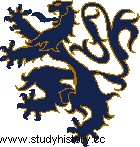 | The bear was previously considered the king of animals, it is gradually replaced by the lion, however the eagle steals the title from him against the birds. As a piece of furniture, it is crawling by default, which for the time means to seize, to catch. But there are many other attitudes, jumping, looking, lying down, sitting... Depending on its posture, the lion (generally with a head in profile) can be called a leopard if its head is facing forward, but it is the same animal. |
|---|---|---|
| The Eagle | 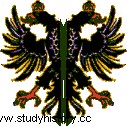 | The eagle was often used as the symbol of the Roman Empire. There are, like the lion, several shapes and arrangements. It can be in particular bicephalous (with two heads) or three-headed. Like the lion, it represents strength and power. |
| The Lily |  | The fleur-de-lys (or lily) exists in several variants, it evolved continuously over time to finally stabilize during the 14th century. Originally, it is attributed the vegetable lily, or a spearhead. It is used to represent the royal arms. In 1364, Charles V brought back this representation to three fleur-de-lys. |
Embracing
We call blazon the way of describing coats of arms according to a conventional language which allows, on its own, to describe the shield without having to draw it. The simplest case is that of the shield which has neither partition nor figure, it is then said to be "plain". Then to emblazon a shield, we always start by stating the field of the shield (by its enamel or metal) then we state the pieces that charge it. If the waiting table of the ecu is divided into partitions, it is always necessary to start by quoting the one which is at the top left (which corresponds for us to the dexter of the ecu). Then come those of the upper part, then those coming below. Each part must be fully described before moving on to the next.
| Ancient France | 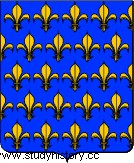 | "Azure, set with fleur-de-lis Or" |
|---|---|---|
| Modern France | 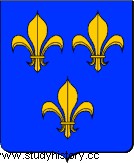 | "Azure, three fleur-de-lis Or" |
| Duchy of Normandy | 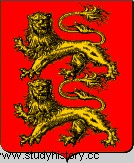 | "Gules, 2 leopards Or" |
| Bertrand du Guesclin | 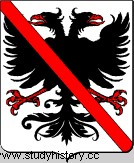 | "Argent, an eagle displayed Sable beaked and membered Gules with a baston of the same debruising in dexter over all" |
